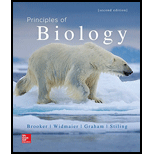
Introduction:
Offspringare the young ones born from living organisms, which are either produced by one organism or, by two organisms (in case of sexual reproduction). Group of offspring may be more commonly referred to as progeny or brood (for example, chickens hatched from one clutch of eggs, offspring of the honeybee). The egg that is not fused with a male gamete (sperm) is called anunfertilized egg.
Answer to Problem 1TY
The correct answer is option (d) parthenogenesis.
Explanation of Solution
Explanation/justification for the correct answer:
Option (d) parthenogenesis. The development of offspring (or young ones) from an unfertilized egg is called parthenogenesis. The offspring (or progeny) produced by parthenogenesis are generally haploid. For example, some invertebrate animals (like aphids, some scorpions, some bees, some mites, etc.), few vertebrate animals (like some reptiles, fish, amphibians, etc.), and some plants. So, this is the correct option.
Explanation for incorrect answer:
Option (a) budding. It is the form of asexual reproduction. In budding, cells of the parents go through mitosis and form a different type of structure called bud or outgrowth before the new individual is produced. So, this is an incorrect option.
Option (c) cloning. Many organisms produce clones through asexual reproduction. In the process of cloning, individuals are produced either artificially or naturally. Progenies of cloning are genetically identical. So, this is an incorrect option.
Option (e) implantation. Implantation refers to the adherence of the fertilized egg to the wall(or lining) of the uterus, which takes place about 6 or 7 days after fertilization (or conception). So, this is an incorrect option.
Parthenogenesis is thegrowth and developmentof offspring (or progeny) from an unfertilized egg. Hence, the correct answer is option (d) parthenogenesis.
Want to see more full solutions like this?
Chapter 39 Solutions
Principles of Biology
- Describe the principle of homeostasis.arrow_forwardExplain how the hormones of the glands listed below travel around the body to target organs and tissues : Pituitary gland Hypothalamus Thyroid Parathyroid Adrenal Pineal Pancreas(islets of langerhans) Gonads (testes and ovaries) Placentaarrow_forwardWhat are the functions of the hormones produced in the glands listed below: Pituitary gland Hypothalamus Thyroid Parathyroid Adrenal Pineal Pancreas(islets of langerhans) Gonads (testes and ovaries) Placentaarrow_forward
- Describe the hormones produced in the glands listed below: Pituitary gland Hypothalamus Thyroid Parathyroid Adrenal Pineal Pancreas(islets of langerhans) Gonads (testes and ovaries) Placentaarrow_forwardPlease help me calculate drug dosage from the following information: Patient weight: 35 pounds, so 15.9 kilograms (got this by dividing 35 pounds by 2.2 kilograms) Drug dose: 0.05mg/kg Drug concentration: 2mg/mLarrow_forwardA 25-year-old woman presents to the emergency department with a 2-day history of fever, chills, severe headache, and confusion. She recently returned from a trip to sub-Saharan Africa, where she did not take malaria prophylaxis. On examination, she is febrile (39.8°C/103.6°F) and hypotensive. Laboratory studies reveal hemoglobin of 8.0 g/dL, platelet count of 50,000/μL, and evidence of hemoglobinuria. A peripheral blood smear shows ring forms and banana-shaped gametocytes. Which of the following Plasmodium species is most likely responsible for her severe symptoms? A. Plasmodium vivax B. Plasmodium ovale C. Plasmodium malariae D. Plasmodium falciparumarrow_forward
- please fill in missing parts , thank youarrow_forwardplease draw in the answers, thank youarrow_forwarda. On this first grid, assume that the DNA and RNA templates are read left to right. DNA DNA mRNA codon tRNA anticodon polypeptide _strand strand C с A T G A U G C A TRP b. Now do this AGAIN assuming that the DNA and RNA templates are read right to left. DNA DNA strand strand C mRNA codon tRNA anticodon polypeptide 0 A T G A U G с A TRParrow_forward
 Human Biology (MindTap Course List)BiologyISBN:9781305112100Author:Cecie Starr, Beverly McMillanPublisher:Cengage Learning
Human Biology (MindTap Course List)BiologyISBN:9781305112100Author:Cecie Starr, Beverly McMillanPublisher:Cengage Learning Concepts of BiologyBiologyISBN:9781938168116Author:Samantha Fowler, Rebecca Roush, James WisePublisher:OpenStax College
Concepts of BiologyBiologyISBN:9781938168116Author:Samantha Fowler, Rebecca Roush, James WisePublisher:OpenStax College Biology: The Unity and Diversity of Life (MindTap...BiologyISBN:9781337408332Author:Cecie Starr, Ralph Taggart, Christine Evers, Lisa StarrPublisher:Cengage Learning
Biology: The Unity and Diversity of Life (MindTap...BiologyISBN:9781337408332Author:Cecie Starr, Ralph Taggart, Christine Evers, Lisa StarrPublisher:Cengage Learning Human Heredity: Principles and Issues (MindTap Co...BiologyISBN:9781305251052Author:Michael CummingsPublisher:Cengage Learning
Human Heredity: Principles and Issues (MindTap Co...BiologyISBN:9781305251052Author:Michael CummingsPublisher:Cengage Learning Biology (MindTap Course List)BiologyISBN:9781337392938Author:Eldra Solomon, Charles Martin, Diana W. Martin, Linda R. BergPublisher:Cengage Learning
Biology (MindTap Course List)BiologyISBN:9781337392938Author:Eldra Solomon, Charles Martin, Diana W. Martin, Linda R. BergPublisher:Cengage Learning





